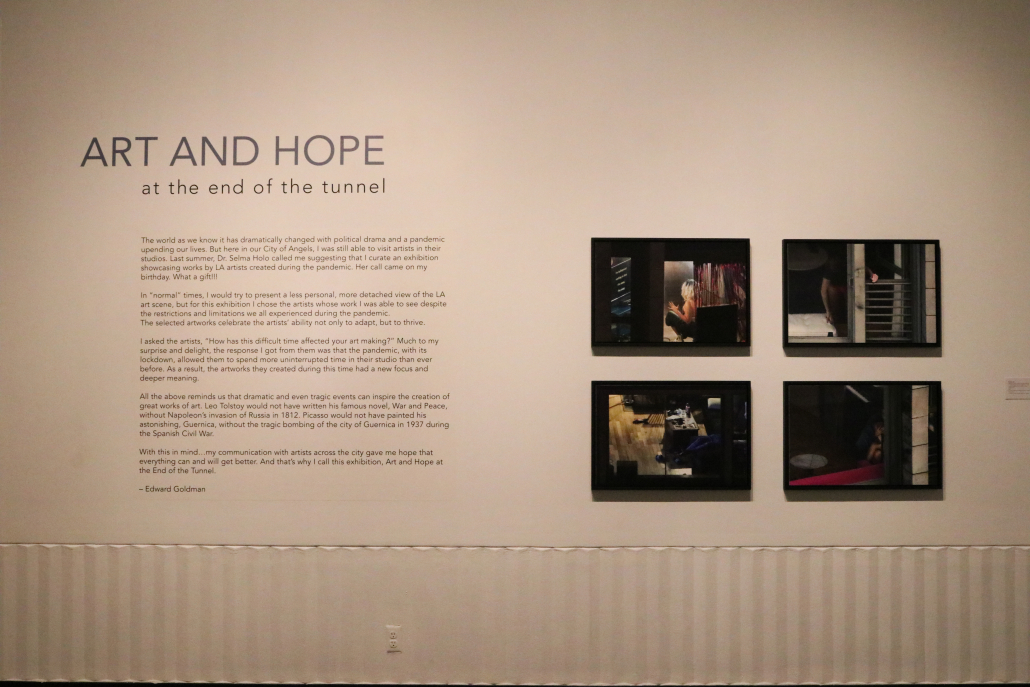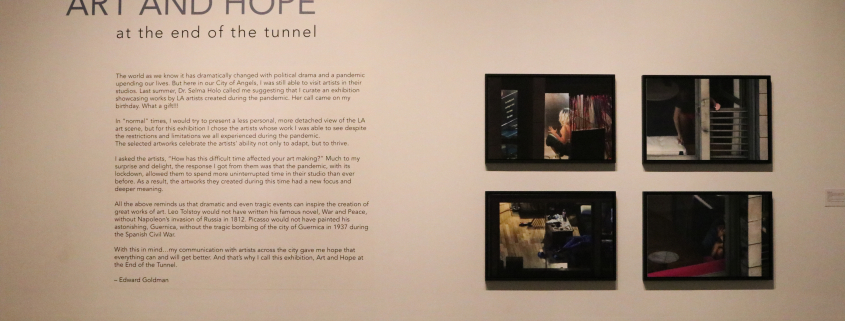New Fisher exhibit reflects on the beauty in endurance

“I took time to look inward and really think about what I want to accomplish with my art. I want to enlighten, entertain and give food for thought.”
Here, Karen Amy Finkel Fishof, a local contemporary artist whose art is prominently featured on the walls of USC Fisher Museum of Art’s newest exhibition, perfectly sums up how it feels to experience “Art and Hope at the end of the tunnel.”
After being closed for over a year (despite briefly reopening in April for a small feature on Dan McCleary), the Fisher Museum revealed “Art and Hope at the End of the Tunnel,” on Sept. 10. The exhibition, curated by Edward Goldman, an art critic and the host of NPR’s “Art Talk”, is centered around art created during the coronavirus pandemic. It serves as an uplifting reminder that art holds power and can be healing in tragic times.
The space itself is a wonderful environment to view art. Artists’ quotes ornament the crisp white walls that support each hanging piece. By showcasing artists of color and creators from a variety of unique backgrounds, it’s clear that the exhibition celebrates diversity within the contemporary art world.
Though the Fisher Museum features art of many different mediums (including amazing quilted tapestries and more abstracted collages), the exhibition excels most in its presentation of various portraits. The portraits displayed a range from Damian Elwes’ Basquiat-inspired canvas to Simon Toparovsky’s futuristic-looking cast aluminum busts and Ken Gonzales-Day’s collection of “Pandemic Portraits” depicting fellow artists, models and friends.
One of the most striking artworks is Brendan Lott’s series of photographs. In these candid images, Lott illustrates beauty and pain in banal existence and the joys and trials of daily life during the pandemic. Inspired by his actual neighbors, the pictures feel as if we recognize the subjects within ourselves — a man making his bed, a woman staring at her phone, an unidentifiable figure reclining on their couch, another singing David Guetta’s “Titanium” on her TV’s karaoke.
In these scenes, there is an ever-present sense of fear, defeat, joy, exhaustion, but most importantly, endurance. Lott reminds us through his work. The pandemic had an emotional and physical toll on many people, and the act of simply enduring these difficult times is something to take pride in and celebrate.
In addition to its focus on portraits, the exhibition also highlights political art. Leo Marmol celebrates his heritage in his series of American and Cuban flag paintings while John Nava’s oil on paper display commemorates a migrant child who faced grave injustice at the Southern border. In choosing such a young subject, Nava recognizes this devastating reality but also reminds the viewer of younger generations and their hope for a better life, ultimately urging the public to support establishing a more humane immigration system.
Other works focus more on the resurgence of the Black Lives Matter movement in 2020. Mark Steven Greenfield’s religious pieces were particularly extraordinary. In his paintings, Black individuals represent several biblical characters in idol-like forms, repurposing the ancient Byzantine style and reclaiming central Christian figures as an integral part of modern Black history. The artist describes this series as “representations of new beginnings,” which perfectly complements the exhibition’s overarching inspiration.
Some of the political commentary does not really fit the theme though. For instance, Keiko Fukazawa’s porcelain profiles of tyrannical leaders, such as Mao Zedong and Donald Trump, miss the mark, focusing more on unequivocal failures in leadership and not enough on a path forward into a better future. While they are well-executed, these ironic commemorative plates do not go well with the idea of hope.
There is a great balance of light-hearted and serious art in the exhibition. While many of the aforementioned works deal with important issues, one piece in particular sticks out as refreshingly playful. Karon Davis’ sculpture titled “Quarantini,” employs a cheeky play on words and shows a woman nonchalantly holding a coral martini glass garnished with an olive. This demonstrates how even in the midst of quarantine, people still found ways to enjoy themselves.
“Art and Hope at the End of the Tunnel” provides a surreal escape from the pandemic, embraces recent profound socio-political movements and acknowledges the beauty of introspective contemplation and the newfound appreciation for life that many artists found over the past year and a half in quarantine.
“Art and Hope at the End of the Tunnel” is on view until Dec. 4, 2021.

